A B C
B C D


A B C
B C D









Copyright © 2024. Vista School Resources, Inc.
Vista School Resources, Inc. is an independent, stand-alone entity that has no relationship, connection, or affiliation whatsoever with any other company, website, platform, person, outfit, organization, or group mentioned herein, even if such name appears on our website, domain, URL, or within the PictureThis! Primary Vocabulary Resource Kit. It should be assumed that no other party, by mere mention of their name herein, has endorsed anything seen here, or that such party has been endorsed by Vista School Resources or the PictureThis! Primary Vocabulary Resource Kit
All rights reserved. No part of the material protected by this copyright may be reproduced in any form by any means, electronic or information storage and retrieval system, without permission in writing from the copyright owner.
Printed in the U.S.A.








This resource provides lessons to enhance beginning language learners and newcomers. It is a go-to resource for students who are learning English. The vocabulary exposure and language practice will help them acquire and improve their English listening, speaking, reading and writing skills.
When working with beginning language learners and newcomers, it is not only important to help them and their families understand U.S. school systems and their policies, but also to become familiar with the English language. Families emigrate for many different reasons including a myriad of difficulties or traumas their children may have previously experienced. When students become acclimated to their new environment in a stress-free way, it helps them lower their natural affective filter to learn a new language and grow in confidence!
There are available resources online such as the U.S. Department of Education’s Newcomer Toolkit found on at https://ncela.ed.gov/educator-support/ toolkits/newcomer-toolkit
The focus of this Vocabulary Resource Kit is to provide lessons with activities and tools that help increase English vocabulary and leverage dictionary usage skills with the PictureThis! Word-to-Word Dictionary included with this resource kit.
W h at We Can Le a r n in E n g l is h
The tools in this kit provide English vocabulary-building activities along with a class set of bilinqual PictureThis! Word-to-Word Dictionaries. The lessons and resources will support students in their language learning journey.
• Support practice in comprehension with translation in their home language
• Expand activities with differentiation techniques to scaffold instruction Students will:
1. Learn and practice the letters of the English alphabet.
2. Learn and practice high frequency sight words.
3. Learn how to use a picture dictionary to help identify the definition (picture) and the translation in their home language.
4. Learn vocabulary (and have fun!) participating in interactive activities for the following topics:
• Animals • Clothing • Colors • Food and Cooking • Learning • Nature • Games
5. Learn action words with dedicated lessons, activities and home learning.
6. Practice with home learning activities that extend and reinforce the lessons. Standards addressed on the following pages.
ENGLISH ALPHABET OVERVIEW
• Print many upper- and lowercase letters
• Demonstrate knowledge of the basic concepts of print:
1. Locate a printed word on a page.
2. Distinguish letters from words within sentences.
3. Match print to speech to demonstrate that language is represented by print.
4. Identify parts of a book (front and back cover, title page).
5. Move top to bottom and left to right on the printed page; returning to the beginning of the next line.
6. Identify all upper- and lowercase letters of the alphabet.
7. Recognize that print conveys specific meaning and pictures may support meaning.
• Use knowledge of grade-appropriate phonics and word analysis skills to decode words accurately:
1. Demonstrate knowledge of the most frequent sound for each consonant.
2. Demonstrate knowledge of the short and long sounds for the five major vowels.
3. Decode consonant-vowel-consonant (CVC) words.
• Encode consonant-vowel-consonant (CVC) words
• Print many upper- and lowercase letters
• Print all upper- and lowercase letters
SYLLABIC AND PHONEMIC AWARENESS
• Demonstrate phonological awareness:
1. Blend and segment syllables in spoken words.
2. Identify and produce alliterative and rhyming words.
3. Blend and segment onset and rimes of single-syllable words.
4. Identify the initial, medial and final sound of spoken words.
5. Add or delete phonemes at the beginning or end of a spoken word and say the resulting word.
6. Segment and blend phonemes in single-syllable spoken words.
• Demonstrate phonological awareness:
1. Segment spoken words into initial, medial and final phonemes, including words with digraphs, blends and trigraphs.
2. Orally blend initial, medial, and final phoneme together to produce a single-syllable spoken word that includes digraphs, blends or trigraphs.
3. Blend single-syllable spoken words with at least five phonemes.
4. Segment single-syllable spoken words with at least five phonemes.
6. Segment and blend phonemes in multi-syllable spoken words.
• Use knowledge of grade appropriate phonics and word-analysis skills to decode words accurately:
1. Decode words using knowledge of spelling-sound correspondences for common consonant digraphs, trigraphs and blends.
2. Decode simple words with r-controlled vowels.
3. Decode and encode regularly spelled one-syllable words.
4. Decode words with inflectional endings.
5. Decode two-syllable words with regular patterns by breaking the words into syllables.
6. Decode words that use final-e and vowel teams to make long-vowel sounds.
• Use knowledge of grade appropriate phonics and word-analysis skills to decode words:
1. Decode words with variable vowel teams (oo, ea, ou) and vowel diphthongs (oi, oy, ow).
2. Decode regularly spelled two-syllable words with long and short vowels.
3. Decode words with open (hi, baby, moment) and closed (bag, sunshine, chop) syllables and consonant - le (purple, circle, stumble).
4. Decode words with common prefixes and suffixes.
5. Decode words with silent letter combinations (knight, comb, island, ghost).
• Recognize and read with automatically grade-level high frequency words
• Use grade-level academic vocabulary appropriately in speaking and writing
• Use a multimedia element to enhance oral or written tasks
• Follow the rules of standard English grammar, punctuation, capitalization and spelling appropriate to grade level
• Use appropriate collaborative techniques and active listening skills when engaging in discussions in a variety of situations
• Follow the rules of standard English grammar, punctuation, capitalization and spelling appropriate to grade level
• Present information orally using complete sentences and appropriate volume
• Follow the rules of standard English grammar, punctuation, capitalization and spelling appropriate to grade levels
• Use a multimedia element to enhance oral or written tasks
• Read grade-level texts with accuracy, automaticity and appropriate prosody or expression:
1. Recognize and read with automaticity the grade-level sight words.
• Use grade level academic vocabulary appropriately in speaking and writing
(continued)
• Identify and use picture clues, context clues, word relationships, reference materials and/or background knowledge to determine the meaning of unknown words
• Use one or more multimedia element(s) to enhance oral or written tasks
• Use grade-level academic vocabulary appropriately in speaking and writing
• English language learners communicate for social and instructional purposes within the school setting
• Demonstrate knowledge of the basic concepts of print:
1. Locate a printed word on a page.
2. Distinguish letters from words within sentences.
3. Match print to speech to demonstrate that language is represented by print.
4. Identify parts of a book (front cover, back cover, title page).
5. Move top to bottom and left to right on the printed page; returning to the beginning of the next line.
6. Identify all upper- and lowercase letters of the alphabet.
7. Recognize that print conveys specific meaning and pictures may support meaning.
• Use appropriate collaborative techniques and active listening skills when engaging in discussions in a variety of situations
• Make inferences to support comprehension
• Read and comprehend grade-level complex texts proficiently
• Using a combination of drawing, dictating, and/or writing, provide factual information about a topic
• With guidance and support from adults, improve drawing and writing, as needed, by planning, revising, and editing
• Present information orally using complete sentences
• Recall information to answer a question about a single topic
• Describe the main character(s), setting, and important events in a story
• Explain the roles of author and illustrator of a story
• Use titles, headings, and illustrations to predict and confirm the topic of texts
• Retell a text orally to enhance comprehension:
1. Use main character(s), setting, and important events for a story.
2. Use topic and details for an informational text.
• With guidance and support from adults, improve writing, as needed, by planning, revising, and editing
• Use a multimedia element to enhance oral or written tasks
• Locate the title, table of contents, names of author(s) and illustrator(s), and glossary of books
• Identify and describe the main story elements in a story
• Use text features including titles, headings, captions, graphs, maps, glossaries, and/or illustrations to demonstrate understanding of texts
• Identify the topic of and relevant details in a text
• Retell a text in oral or written form to enhance comprehension:
1. Use main story elements at the beginning, middle, and end for a literary text.
2. Use topic and important details for an informational text.
• Use grade-level academic vocabulary appropriately in speaking and writing
• Write personal or fictional narratives using a logical sequence of events, transitions, and an ending
• Present information orally using complete sentences, appropriate volume, and clear pronunciation
• Follow the rules of standard English grammar, punctuation, capitalization, and spelling appropriate to grade level.
• Use one or more multimedia element(s) to enhance oral or written tasks
• Explain how text features - including titles, headings, captions, graphs, maps, glossaries, and/or illustrations - contribute to the meaning of texts
• Retell a text to enhance comprehension:
1. Use main story elements in a logical sequence for a literary text.
• Use the central idea and relevant details for an informational text
• Use grade-level academic vocabulary appropriately in speaking and writing.
• English language learners communicate information, ideas and concepts necessary for academic success in the content area of Language Arts
• English language learners communicate for social and instructional purposes within the school setting
INTRODUCING THE DICTIONARY
• Make inferences to support comprehension
• Demonstrate knowledge of the basic concepts of print:
1. Locate a printed word on a page.
2. Distinguish letters from words within sentences.
3. Match print to speech to demonstrate that language is represented by print.
(continued)
4. Identify parts of a book (front cover, back cover, title page).
5. Move top to bottom and left to right on the printed page; returning to the beginning of the next line.
6. Identify all upper- and lowercase letters of the alphabet.
7. Recognize that print conveys specific meaning and pictures may support meaning.
• Demonstrate phonological awareness:
1. Blend and segment syllables in spoken words.
2. Identify and produce alliterative and rhyming words.
3. Blend and segment onset and rimes of single-syllable words.
4. Identify the initial, medial, and final sound of spoken words.
5. Add or delete phonemes at the beginning or end of a spoken word and say the resulting word.
6. Segment and blend phonemes in single-syllable spoken words.
• Use knowledge of grade-appropriate phonics and word-analysis skills to decode words accurately:
1. Demonstrate knowledge of the most frequent sound for each consonant.
2. Demonstrate knowledge of the short and long sounds for the five major vowels.
3. Decode consonant-vowel-consonant (CVC) words.
4. Encode consonant-vowel-consonant (CVC) words.
• Use titles, headings, and illustrations to predict and confirm the topic of texts
• Locate the title, table of contents, names of author(s) and illustrator(s), and glossary of books
• Demonstrate phonological awareness:
1. Segment spoken words into initial, medial, and final phonemes, including words with digraphs, blends, and trigraphs
2. Orally blend initial, medial, and final phonemes together to produce a single-syllable word that includes digraphs, blends, or trigraphs.
3. Blend single-syllable spoken words with at least five phonemes.
4. Segment single-syllable spoken words with at least five phonemes.
5. Segment and blend phonemes in multi-syllable spoken words.
• Use knowledge of grade-appropriate phonics and word-analysis skills to decode words accurately:
1. Decode words using knowledge of spelling-sound correspondences for common consonant digraphs, trigraphs, and blends.
2. Decode simple words with r-controlled vowels.
3. Decode and encode regularly spelled one-syllable words.
4. Decode words with inflectional endings.
5. Decode two-syllable words with regular patterns by breaking the words into syllables.
6. Decode words that use final –e and vowel teams to make long-vowel sound.
• Identify and use frequently occurring base words and their common inflections in grade-level content
• Identify and use picture clues, context clues, word relationships, reference materials, and/or background knowledge to determine the meaning of unknown words
• Use knowledge of grade-appropriate phonics and word-analysis skills to decode words:
1. Decode words with variable vowel teams (oo, ea, ou) and vowel diphthongs (oi, oy, ow).
2. Decode regularly spelled two-syllable words with long and short vowels.
3. Decode words with open (hi, baby, moment) and closed (bag, sunshine, chop) syllables and consonant -le (purple, circle, stumble).
4. Decode words with common prefixes and suffixes.
5. Decode words with silent letter combinations (knight, comb, island, ghost).
• Use grade-level academic vocabulary appropriately in speaking and writing:
1. Identify and use base words and affixes to determine the meaning of unfamiliar words in grade-level content.
• Identify and use context clues, word relationships, reference materials, and/or background knowledge to determine the meaning of unknown words
• English language learners communicate information, ideas and concepts necessary for academic success in the content area of Language Arts
• English language learners communicate for social and instructional purposes within the school setting
ACTIVITIES
ACTIVITY #1 SPEAKING OF PICTURES
• Use appropriate collaborative techniques and active listening skills when engaging in discussions in a variety of situations
• Present information orally using complete sentences
• Use a multimedia element to enhance oral or written tasks
• Use grade-level academic vocabulary appropriately in speaking and writing
• Ask and answer questions about unfamiliar words in grade-level content
• Identify and sort common words into basic categories, relating vocabulary to background knowledge
• Print all upper- and lowercase letters
• Present information orally using complete sentences and appropriate volume
• Follow the rules of standard English grammar, punctuation, capitalization, and spelling appropriate to grade level
• Demonstrate phonological awareness:
1. Segment spoken words into initial, medial, and final phonemes, including words with digraphs, blends, and trigraphs.
ACTIVITY #1 SPEAKING OF PICTURES (continued)
2. Orally blend initial, medial, and final phonemes together to produce a single-syllable word that includes digraphs, blends, or trigraphs.
3. Blend single-syllable spoken words with at least five phonemes.
4. Segment single-syllable spoken words with at least five phonemes.
5. Segment and blend phonemes in multi-syllable spoken words.
• Use knowledge of grade-appropriate phonics and word-analysis skills to decode words accurately:
1. Decode words using knowledge of spelling-sound correspondences for common consonant digraphs, trigraphs, and blends.
2. Decode simple words with r-controlled vowels.
3. Decode and encode regularly spelled one-syllable words.
4. Decode words with inflectional endings.
5. Decode two-syllable words with regular patterns by breaking the words into syllables.
6. Decode words that use final –e and vowel teams to make long-vowel sound.
• Use grade-level academic vocabulary appropriately in speaking and writing
• Identify and use frequently occurring base words and their common inflections in grade-level content
• Identify and use picture clues, context clues, word relationships, reference materials, and/or background knowledge to determine the meaning of unknown words
• Demonstrate legible printing skills
• Present information orally using complete sentences, appropriate volume, and clear pronunciation
• Use knowledge of grade-appropriate phonics and word-analysis skills to decode words:
1. Decode words with variable vowel teams (oo, ea, ou) and vowel diphthongs (oi, oy, ow).
2. Decode regularly spelled two-syllable words with long and short vowels.
3. Decode words with open (hi, baby, moment) and closed (bag, sunshine, chop) syllables and consonant -le (purple, circle, stumble).
4. Decode words with common prefixes and suffixes.
5. Decode words with silent letter combinations (knight, comb, island, ghost).
• English language learners communicate information, ideas and concepts necessary for academic success in the content area of Language Arts
• English language learners communicate for social and instructional purposes within the school setting
• Use appropriate collaborative techniques and active listening skills when engaging in discussions in a variety of situations
• Present information orally using complete sentences
• Use a multimedia element to enhance oral or written tasks
• Use grade-level academic vocabulary appropriately in speaking and writing
• Ask and answer questions about unfamiliar words in grade-level content
• Identify and sort common words into basic categories, relating vocabulary to background knowledge
• Print all upper- and lowercase letters
• Present information orally using complete sentences and appropriate volume
• Follow the rules of standard English grammar, punctuation, capitalization, and spelling appropriate to grade level
• Demonstrate phonological awareness:
1. Segment spoken words into initial, medial, and final phonemes, including words with digraphs, blends, and trigraphs.
2. Orally blend initial, medial, and final phonemes together to produce a single-syllable word that includes digraphs, blends, or trigraphs.
3. Blend single-syllable spoken words with at least five phonemes.
4. Segment single-syllable spoken words with at least five phonemes.
5. Segment and blend phonemes in multi-syllable spoken words.
• Use knowledge of grade-appropriate phonics and word-analysis skills to decode words accurately:
1. Decode words using knowledge of spelling-sound correspondences for common consonant digraphs, trigraphs, and blends.
2. Decode simple words with r-controlled vowels.
3. Decode and encode regularly spelled one-syllable words.
4. Decode words with inflectional endings.
5. Decode two-syllable words with regular patterns by breaking the words into syllables.
5. Decode words that use final –e and vowel teams to make long-vowel sound.
• Use grade-level academic vocabulary appropriately in speaking and writing
• Identify and use frequently occurring base words and their common inflections in grade-level content
• Identify and use picture clues, context clues, word relationships, reference materials, and/or background knowledge to determine the meaning of unknown words
• Demonstrate legible printing skills
• Improve writing as needed by planning, revising, and editing with guidance and support from adults and feedback from peers
• Present information orally using complete sentences, appropriate volume, and clear pronunciation
• Use digital tools to produce and publish writing individually or with peers and with support from adults
(continued)
ACTIVITY
(continued)
• Use knowledge of grade-appropriate phonics and word-analysis skills to decode words:
1. Decode words with variable vowel teams (oo, ea, ou) and vowel diphthongs (oi, oy, ow).
2. Decode regularly spelled two-syllable words with long and short vowels.
3. Decode words with open (hi, baby, moment) and closed (bag, sunshine, chop) syllables and consonant -le (purple, circle, stumble).
4. Decode words with common prefixes and suffixes.
5. Decode words with silent letter combinations (knight, comb, island, ghost).
• English language learners communicate information, ideas and concepts necessary for academic success in the content area of Language Arts
• English language learners communicate for social and instructional purposes within the school setting
ACTIVITY
• Use appropriate collaborative techniques and active listening skills when engaging in discussions in a variety of situations
• Present information orally using complete sentences
• Use a multimedia element to enhance oral or written tasks
• Recognize and read with automaticity grade-level high frequency words
• Use grade-level academic vocabulary appropriately in speaking and writing
• Ask and answer questions about unfamiliar words in grade-level content
• Identify and sort common words into basic categories, relating vocabulary to background knowledge
• Print all upper- and lowercase letters
• Present information orally using complete sentences and appropriate volume
• Follow the rules of standard English grammar, punctuation, capitalization, and spelling appropriate to grade level
• Demonstrate phonological awareness:
1. Segment spoken words into initial, medial, and final phonemes, including words with digraphs, blends, and trigraphs.
2. Orally blend initial, medial, and final phonemes together to produce a single-syllable word that includes digraphs, blends, or trigraphs.
3. Blend single-syllable spoken words with at least five phonemes.
4. Segment single-syllable spoken words with at least five phonemes.
5. Segment and blend phonemes in multi-syllable spoken words.
• Use knowledge of grade-appropriate phonics and word-analysis skills to decode words accurately:
1. Decode words using knowledge of spelling-sound correspondences for common consonant digraphs, trigraphs, and blends.
2. Decode simple words with r-controlled vowels.
3. Decode and encode regularly spelled one-syllable words.
4. Decode words with inflectional endings.
5. Decode two-syllable words with regular patterns by breaking the words into syllables.
6. Decode words that use final –e and vowel teams to make long-vowel sound.
• Read grade-level texts with accuracy, automaticity, and appropriate prosody or expression
• Recognize and read with automaticity the grade-level sight words
• Use grade-level academic vocabulary appropriately in speaking and writing
• Identify and use frequently occurring base words and their common inflections in grade-level content
• Identify and use picture clues, context clues, word relationships, reference materials, and/or background knowledge to determine the meaning of unknown words
• Demonstrate legible printing skills
• Improve writing as needed by planning, revising, and editing with guidance and support from adults and feedback from peers
• Present information orally using complete sentences, appropriate volume, and clear pronunciation
• Use digital tools to produce and publish writing individually or with peers and with support from adults
• Use knowledge of grade-appropriate phonics and word-analysis skills to decode words:
1. Decode words with variable vowel teams (oo, ea, ou) and vowel diphthongs (oi, oy, ow).
2. Decode regularly spelled two-syllable words with long and short vowels.
3. Decode words with open (hi, baby, moment) and closed (bag, sunshine, chop) syllables and consonant -le (purple, circle, stumble).
4. Decode words with common prefixes and suffixes.
5. Decode words with silent letter combinations (knight, comb, island, ghost).
• English language learners communicate information, ideas and concepts necessary for academic success in the content area of Language Arts
• English language learners communicate for social and instructional purposes within the school setting
• Use appropriate collaborative techniques and active listening skills when engaging in discussions in a variety of situations
• Present information orally using complete sentences
ACTIVITY #4 MEMORY GAME (continued)
• Use a multimedia element to enhance oral or written tasks
• Recognize and read with automaticity gradelevel high frequency words
• Use grade-level academic vocabulary appropriately in speaking and writing
• Ask and answer questions about unfamiliar words in grade-level content
• Identify and sort common words into basic categories, relating vocabulary to background knowledge
• Print all upper- and lowercase letters
• Present information orally using complete sentences and appropriate volume.
• Follow the rules of standard English grammar, punctuation, capitalization, and spelling appropriate to grade level.
• Demonstrate phonological awareness:
1. Segment spoken words into initial, medial, and final phonemes, including words with digraphs, blends, and trigraphs.
2. Orally blend initial, medial, and final phonemes together to produce a single-syllable word that includes digraphs, blends, or trigraphs.
3. Blend single-syllable spoken words with at least five phonemes.
4. Segment single-syllable spoken words with at least five phonemes.
5. Segment and blend phonemes in multisyllable spoken words.
• Use knowledge of grade-appropriate phonics and word-analysis skills to decode words:
1. Decode words using knowledge of spelling-sound correspondences for common consonant digraphs, trigraphs, and blends.
2. Decode simple words with r-controlled vowels.
3. Decode and encode regularly spelled one-syllable words.
4. Decode words with inflectional endings.
5. Decode two-syllable words with regular patterns by breaking the words into syllables.
6. Decode words that use final –e and vowel teams to make long-vowel sound.
• Read grade-level texts with accuracy, automaticity, and appropriate prosody or expression
• Recognize and read with automaticity the grade-level sight words
• Use grade-level academic vocabulary appropriately in speaking and writing
• Identify and use frequently occurring base words and their common inflections in grade-level content
• Identify and use picture clues, context clues, word relationships, reference materials, and/or background knowledge to determine the meaning of unknown words
• Demonstrate legible printing skills
• Improve writing as needed by planning, revising, and editing with guidance and support from adults and feedback from peers
• Present information orally using complete sentences, appropriate volume, and clear pronunciation
• Use knowledge of grade-appropriate phonics and word-analysis skills to decode words:
1. Decode words with variable vowel teams (oo, ea, ou) and vowel diphthongs (oi, oy, ow).
2. Decode regularly spelled two-syllable words with long and short vowels.
3. Decode words with open (hi, baby, moment) and closed (bag, sunshine, chop) syllables and consonant -le (purple, circle, stumble).
4. Decode words with common prefixes and suffixes.
5. Decode words with silent letter combinations (knight, comb, island, ghost).
• English language learners communicate information, ideas and concepts necessary for academic success in the content area of Language Arts
• English language learners communicate for social and instructional purposes within the school setting
ACTIVITY #5 WORD SORT
• Use appropriate collaborative techniques and active listening skills when engaging in discussions in a variety of situations
• Present information orally using complete sentences
• Use grade-level academic vocabulary appropriately in speaking and writing
• Ask and answer questions about unfamiliar words in grade-level content
• Identify and sort common words into basic categories, relating vocabulary to background knowledge
• Print all upper- and lowercase letters
• Present information orally using complete sentences and appropriate volume
• Follow the rules of standard English grammar, punctuation, capitalization, and spelling appropriate to grade level
• Demonstrate phonological awareness:
1. Segment spoken words into initial, medial, and final phonemes, including words with digraphs, blends, and trigraphs.
2. Orally blend initial, medial, and final phonemes together to produce a single-syllable word that includes digraphs, blends, or trigraphs.
3. Blend single-syllable spoken words with at least five phonemes.
4. Segment single-syllable spoken words with at least five phonemes.
5. Segment and blend phonemes in multi-syllable spoken words.
• Use knowledge of grade-appropriate phonics and word-analysis skills to decode words accurately:
1. Decode words using knowledge of spelling-sound correspondences for common consonant digraphs, trigraphs, and blends.
2. Decode simple words with r-controlled vowels.
3. Decode and encode regularly spelled one-syllable words.
4. Decode words with inflectional endings.
5. Decode two-syllable words with regular patterns by breaking the words into syllables.
6. Decode words that use final –e and vowel teams to make long-vowel sound.
• Use grade-level academic vocabulary appropriately in speaking and writing
• Identify and use picture clues, context clues, word relationships, reference materials, and/or background knowledge to determine the meaning of unknown words
• Demonstrate legible printing skills
• Present information orally using complete sentences, appropriate volume, and clear pronunciation
• Use knowledge of grade-appropriate phonics and word-analysis skills to decode words:
1. Decode words with variable vowel teams (oo, ea, ou) and vowel diphthongs (oi, oy, ow).
2. Decode regularly spelled two-syllable words with long and short vowels.
3. Decode words with open (hi, baby, moment) and closed (bag, sunshine, chop) syllables and consonant -le (purple, circle, stumble).
4. Decode words with common prefixes and suffixes.
5. Decode words with silent letter combinations (knight, comb, island, ghost).
• English language learners communicate information, ideas and concepts necessary for academic success in the content area of Language Arts
• English language learners communicate for social and instructional purposes within the school setting
• Read and comprehend grade-level complex texts proficiently
• Make inferences to support comprehension
• Use appropriate collaborative techniques and active listening skills when engaging in discussions in a variety of situations
• Use appropriate voice and tone when speaking or writing
• Print many upper- and lowercase letters
• Using a combination of drawing, dictating, and/or writing, create narratives with the events in chronological order
• With guidance and support from adults, improve drawing and writing, as needed, by planning, revising, and editing
• Present information orally using complete sentences
• Follow the rules of standard English grammar, punctuation, capitalization, and spelling appropriate to grade level
• Identify and explain descriptive words in text(s)
• Retell a text orally to enhance comprehension:
1. Use main character(s), setting, and important events for a story.
2. Use topic and details for an informational text.
• Use grade-level academic vocabulary appropriately in speaking and writing
• Ask and answer questions about unfamiliar words in grade-level content
• With guidance and support from adults, improve writing, as needed, by planning, revising, and editing
• Present information orally using complete sentences and appropriate volume
• Follow the rules of standard English grammar, punctuation, capitalization, and spelling appropriate to grade level
• Identify and use digital tools to produce and publish writing individually or with peers and with support from adults
• Read grade-level texts with accuracy, automaticity, and appropriate prosody or expression:
1. Recognize and read with automaticity the grade-level sight words
• Identify the topic of and relevant details in a text
• Identify and explain descriptive words and phrases in text(s)
• Retell a text in oral or written form to enhance comprehension:
1. Use main story elements at the beginning, middle, and end for a literary text.
2. Use topic and important details for an informational text.
• Use grade-level academic vocabulary appropriately in speaking and writing
• Identify and use picture clues, context clues, word relationships, reference materials, and/or background knowledge to determine the meaning of unknown words
• Demonstrate legible printing skills
• Improve writing as needed by planning, revising, and editing with guidance and support from adults and feedback from peers
• Present information orally using complete sentences, appropriate volume, and clear pronunciation
• Follow the rules of standard English grammar, punctuation, capitalization, and spelling appropriate to grade level
• Use knowledge of grade-appropriate phonics and word-analysis skills to decode words:
1. Decode words with variable vowel teams (oo, ea, ou) and vowel diphthongs (oi, oy, ow).
2. Decode regularly spelled two-syllable words with long and short vowels.
3. Decode words with open (hi, baby, moment) and closed (bag, sunshine, chop) syllables and consonant -le (purple, circle, stumble).
ACTIVITY #6 ACTION WORDS CHARADES/FILL IN THE ACTION WORDS (continued)
4. Decode words with common prefixes and suffixes.
5. Decode words with silent letter combinations (knight, comb, island, ghost).
• Read grade-level texts with accuracy, automaticity, and appropriate prosody or expression
• Retell a text to enhance comprehension:
1. Use main story elements in a logical sequence for a literary text.
• Use the central idea and relevant details for an informational text
• Use grade-level academic vocabulary appropriately in speaking and writing
• Identify and use context clues, word relationships, reference materials, and/or background knowledge to determine the meaning of unknown words
• English language learners communicate information, ideas and concepts necessary for academic success in the content area of Language Arts
• English language learners communicate for social and instructional purposes within the school setting
• Use appropriate collaborative techniques and active listening skills when engaging in discussions in a variety of situations
• Present information orally using complete sentences
• Follow the rules of standard English grammar, punctuation, capitalization, and spelling appropriate to grade level
• Use a multimedia element to enhance oral or written tasks
• Use grade-level academic vocabulary appropriately in speaking and writing
• Ask and answer questions about unfamiliar words in grade-level content
• Identify and sort common words into basic categories, relating vocabulary to background knowledge
• Present information orally using complete sentences and appropriate volume
• Use a multimedia element to enhance oral or written tasks
• Identify and explain descriptive words and phrases in text(s)
• Retell a text in oral or written form to enhance comprehension:
1. Use main story elements at the beginning, middle, and end for a literary text.
2. Use topic and important details for an informational text.
• Use grade-level academic vocabulary appropriately in speaking and writing
• Present information orally using complete sentences, appropriate volume, and clear pronunciation
• Follow the rules of standard English grammar, punctuation, capitalization, and spelling appropriate to grade level
• Use one or more multimedia element(s) to enhance oral or written tasks
• Retell a text to enhance comprehension:
1. Use main story elements at the beginning, middle, and end for a literary text.
• Use the central idea and relevant details for an informational text
• Use grade-level academic vocabulary appropriately in speaking and writing
• Identify and use context clues, word relationships, reference materials, and/or background knowledge to determine the meaning of unknown words
• English language learners communicate information, ideas and concepts necessary for academic success in the content area of Language Arts
• English language learners communicate for social and instructional purposes within the school setting
• Use appropriate collaborative techniques and active listening skills when engaging in discussions in a variety of situations
• Present information orally using complete sentences
• Follow the rules of standard English grammar, punctuation, capitalization, and spelling appropriate to grade level
• Use a multimedia element to enhance oral or written tasks
• Use grade-level academic vocabulary appropriately in speaking and writing
• Ask and answer questions about unfamiliar words in grade-level content
• Identify and sort common words into basic categories, relating vocabulary to background knowledge
• Present information orally using complete sentences
• Use a multimedia element to enhance oral or written tasks
• Identify and explain descriptive words and phrases in text(s)
• Retell a text in oral or written form to enhance comprehension:
1. Use main story elements at the beginning, middle, and end for a literary text.
2. Use topic and important details for an informational text.
ACTIVITY #8 ACTION WORDS
(continued)
• Use grade-level academic vocabulary appropriately in speaking and writing
• Present invormation orally using complete sentences, appropriate volume and clear pronunciation
• Follow the rules of standard English grammar, punctuation, capitalization, and spelling appropriate to grade level
• Use grade-level academic vocabulary appropriately in speaking and writing
• Present information orally using complete sentences, appropriate volume, and clear pronunciation
• Use one or more multimedia element(s) to enhance oral or written tasks
• Retell a text to enhance comprehension:
1. Use main story elements in a logical sequence for a literary text.
• Use the central idea and relevant details for an informational text
• Use grade-level academic vocabulary appropriately in speaking and writing
• Identify and use context clues, word relationships, reference materials, and/or background knowledge to determine the meaning of unknown words
• English language learners communicate information, ideas and concepts necessary for academic success in the content area of Language Arts
• English language learners communicate for social and instructional purposes within the school setting
THEMATIC ACTIVITY #1 WEATHER
• Use appropriate collaborative techniques and active listening skills when engaging in discussions in a variety of situations
• Use appropriate voice and tone when speaking or writing
• Using a combination of drawing, dictating, and/or writing, express opinions about a topic or text with at least one supporting reason
• Present information orally using complete sentences
• Follow the rules of standard English grammar, punctuation, capitalization, and spelling appropriate to grade level.
• Use a multimedia element to enhance oral or written tasks
• Identify and sort common words into basic categories, relating vocabulary to background knowledge
• Present information orally using complete sentences and appropriate volume
• Follow the rules of standard English grammar, punctuation, capitalization, and spelling appropriate to grade level
• Participate in research to gather information to answer a question about a single topic
• Use a multimedia element to enhance oral or written tasks
• Identify and use digital tools to produce and publish writing individually or with peers and with support from adults
• Demonstrate phonological awareness:
1. Segment spoken words into initial, medial, and final phonemes, including words with digraphs, blends, and trigraphs.
2. Orally blend initial, medial, and final phonemes together to produce a single-syllable word that includes digraphs, blends, or trigraphs.
3. Blend single-syllable spoken words with at least five phonemes.
4. Segment single-syllable spoken words with at least five phonemes.
5. Segment and blend phonemes in multi-syllable spoken words.
• Use knowledge of grade-appropriate phonics and word-analysis skills to decode words accurately:
1. Decode words using knowledge of spelling-sound correspondences for common consonant digraphs, trigraphs, and blends.
2. Decode simple words with r-controlled vowels.
3. Decode and encode regularly spelled one-syllable words.
4. Decode words with inflectional endings.
5. Decode two-syllable words with regular patterns by breaking the words into syllables.
6. Decode words that use final –e and vowel teams to make long-vowel sound.
• Read grade-level texts with accuracy, automaticity, and appropriate prosody or expression:
1. Recognize and read with automaticity the grade-level sight words.
• Use grade-level academic vocabulary appropriately in speaking and writing
• Identify and use frequently occurring base words and their common inflections in grade-level content
• Identify and use picture clues, context clues, word relationships, reference materials, and/or background knowledge to determine the meaning of unknown words
• Write personal or fictional narratives using a logical sequence of events, transitions, and an ending
• Follow the rules of standard English grammar, punctuation, capitalization, and spelling appropriate to grade level
• Participate in research to gather information to answer a question about a single topic using multiple sources
• Use one or more multimedia element(s) to enhance oral or written tasks
• Use digital tools to produce and publish writing individually or with peers and with support from adults
THEMATIC ACTIVITY #1 WEATHER WATCHERS (continued)
• Use knowledge of grade-appropriate phonics and word-analysis skills to decode words:
1. Decode words with variable vowel teams (oo, ea, ou) and vowel diphthongs (oi, oy, ow).
2. Decode regularly spelled two-syllable words with long and short vowels. 3. Decode words with open (hi, baby, moment) and closed (bag, sunshine, chop) syllables and consonant -le (purple, circle, stumble).
4. Decode words with common prefixes and suffixes.
5. Decode words with silent letter combinations (knight, comb, island, ghost).
• Read grade-level texts with accuracy, automaticity, and appropriate prosody or expression
• English language learners communicate information, ideas and concepts necessary for academic success in the content area of Language Arts
• English language learners communicate for social and instructional purposes within the school setting
THEMATIC ACTIVITY
• Use appropriate collaborative techniques and active listening skills when engaging in discussions in a variety of situations
• Use appropriate voice and tone when speaking or writing
• Using a combination of drawing, dictating, and/or writing, express opinions about a topic or text with at least one supporting reason
• Present information orally using complete sentences
• Follow the rules of standard English grammar, punctuation, capitalization, and spelling appropriate to grade level
• Use a multimedia element to enhance oral or written tasks
• Identify and sort common words into basic categories, relating vocabulary to background knowledge
• Present information orally using complete sentences and appropriate volume
• Follow the rules of standard English grammar, punctuation, capitalization, and spelling appropriate to grade level
• Participate in research to gather information to answer a question about a single topic
• Use a multimedia element to enhance oral or written tasks
• Identify and use digital tools to produce and publish writing individually or with peers and with support from adults
• Demonstrate phonological awareness:
1. Segment spoken words into initial, medial, and final phonemes, including words with digraphs, blends, and trigraphs.
2. Orally blend initial, medial, and final phonemes together to produce a single-syllable word that includes digraphs, blends, or trigraphs.
3. Blend single-syllable spoken words with at least five phonemes.
4. Segment single-syllable spoken words with at least five phonemes.
5. Segment and blend phonemes in multi-syllable spoken words.
• Use knowledge of grade-appropriate phonics and word-analysis skills to decode words accurately:
1. Decode words using knowledge of spelling-sound correspondences for common consonant digraphs, trigraphs, and blends.
2. Decode simple words with r-controlled vowels.
3. Decode and encode regularly spelled one-syllable words.
4. Decode words with inflectional endings.
5. Decode two-syllable words with regular patterns by breaking the words into syllables.
6. Decode words that use final –e and vowel teams to make long-vowel sound.
• Read grade-level texts with accuracy, automaticity, and appropriate prosody or expression:
1. Recognize and read with automaticity the grade-level sight words.
• Use grade-level academic vocabulary appropriately in speaking and writing
• Identify and use frequently occurring base words and their common inflections in grade-level content
• Identify and use picture clues, context clues, word relationships, reference materials, and/or background knowledge to determine the meaning of unknown words
• Write personal or fictional narratives using a logical sequence of events, transitions, and an ending
• Follow the rules of standard English grammar, punctuation, capitalization, and spelling appropriate to grade level
• Participate in research to gather information to answer a question about a single topic using multiple sources
• Use one or more multimedia element(s) to enhance oral or written tasks
• Use digital tools to produce and publish writing individually or with peers and with support from adults
• Use knowledge of grade-appropriate phonics and word-analysis skills to decode words:
1. Decode words with variable vowel teams (oo, ea, ou) and vowel diphthongs (oi, oy, ow).
2. Decode regularly spelled two-syllable words with long and short vowels.
3. Decode words with open (hi, baby, moment) and closed (bag, sunshine, chop) syllables and consonant -le (purple, circle, stumble).
4. Decode words with common prefixes and suffixes.
5. Decode words with silent letter combinations (knight, comb, island, ghost).
• Read grade-level texts with accuracy, automaticity, and appropriate prosody or expression
THEMATIC ACTIVITY #2 ANIMAL GUESSING GAME (continued)
• English language learners communicate information, ideas and concepts necessary for academic success in the content area of Language Arts
• English language learners communicate for social and instructional purposes within the school setting
THEMATIC ACTIVITY
• Make inferences to support comprehension
• Use appropriate collaborative techniques and active listening skills when engaging in discussions in a variety of situations
• Using a combination of drawing, dictating, and/or writing, express opinions about a topic or text with at least one supporting reason
• With guidance and support from adults, improve drawing and writing, as needed, by planning, revising, and editing
• Present information orally using complete sentences
• Follow the rules of standard English grammar, punctuation, capitalization, and spelling appropriate to grade level
• Recall information to answer a question about a single topic
• Use a multimedia element to enhance oral or written tasks
• Identify and explain descriptive words in text(s)
• Ask and answer questions about unfamiliar words in grade-level content
• Write opinions about a topic or text with at least one supporting reason from a source and a sense of closure
• With guidance and support from adults, improve writing, as needed, by planning, revising, and editing
• Present information orally using complete sentences and appropriate volume
• Follow the rules of standard English grammar, punctuation, capitalization, and spelling appropriate to grade level
• Participate in research to gather information to answer a question about a single topic
• Use a multimedia element to enhance oral or written tasks
• Identify and explain descriptive words and phrases in text(s)
• Identify and use picture clues, context clues, word relationships, reference materials, and/or background knowledge to determine the meaning of unknown words
• Demonstrate legible printing skills
• Write expository texts about a topic, using a source, providing an introduction, facts, transitions, and a conclusion
• Improve writing as needed by planning, revising, and editing with guidance and support from adults and feedback from peers
• Present information orally using complete sentences, appropriate volume, and clear pronunciation
• Follow the rules of standard English grammar, punctuation, capitalization, and spelling appropriate to grade level
• Participate in research to gather information to answer a question about a single topic using multiple sources
• Use one or more multimedia element(s) to enhance oral or written tasks
• Use grade-level academic vocabulary appropriately in speaking and writing
• Identify and use context clues, word relationships, reference materials, and/or background knowledge to determine the meaning of unknown words
• English language learners communicate information, ideas and concepts necessary for academic success in the content area of Language Arts
• English language learners communicate for social and instructional purposes within the school setting
THEMATIC ACTIVITY #4 DRESS UP
• Make inferences to support comprehension
• Use appropriate collaborative techniques and active listening skills when engaging in discussions in a variety of situations
• Using a combination of drawing, dictating, and/or writing, express opinions about a topic or text with at least one supporting reason
• With guidance and support from adults, improve drawing and writing, as needed, by planning, revising, and editing
• Present information orally using complete sentences
• Follow the rules of standard English grammar, punctuation, capitalization, and spelling appropriate to grade level
• Recall information to answer a question about a single topic
• Use a multimedia element to enhance oral or written tasks
• Identify and explain descriptive words in text(s)
• Ask and answer questions about unfamiliar words in grade-level content
• Write opinions about a topic or text with at least one supporting reason from a source and a sense of closure
• With guidance and support from adults, improve writing, as needed, by planning, revising, and editing
• Present information orally using complete sentences and appropriate volume
THEMATIC ACTIVITY #4 DRESS UP (continued)
• Follow the rules of standard English grammar, punctuation, capitalization, and spelling appropriate to grade level
• Participate in research to gather information to answer a question about a single topic
• Use a multimedia element to enhance oral or written tasks
• Identify and explain descriptive words and phrases in text(s)
• Identify and use picture clues, context clues, word relationships, reference materials, and/or background knowledge to determine the meaning of unknown words
• Demonstrate legible printing skills
• Write expository texts about a topic, using a source, providing an introduction, facts, transitions, and a conclusion
• Improve writing as needed by planning, revising, and editing with guidance and support from adults and feedback from peers
• Present information orally using complete sentences, appropriate volume, and clear pronunciation
• Follow the rules of standard English grammar, punctuation, capitalization, and spelling appropriate to grade level
• Participate in research to gather information to answer a question about a single topic using multiple sources
• Use one or more multimedia element(s) to enhance oral or written tasks
• Use grade-level academic vocabulary appropriately in speaking and writing
• Identify and use context clues, word relationships, reference materials, and/or background knowledge to determine the meaning of unknown words
• English language learners communicate information, ideas and concepts necessary for academic success in the content area of Language Arts
• English language learners communicate for social and instructional purposes within the school setting
• Make inferences to support comprehension
• Use appropriate collaborative techniques and active listening skills when engaging in discussions in a variety of situations
• Using a combination of drawing, dictating, and/or writing, express opinions about a topic or text with at least one supporting reason
• With guidance and support from adults, improve drawing and writing, as needed, by planning, revising, and editing
• Present information orally using complete sentences
• Follow the rules of standard English grammar, punctuation, capitalization, and spelling appropriate to grade level
• Recall information to answer a question about a single topic
• Use a multimedia element to enhance oral or written tasks
• Identify and explain descriptive words in text(s)
• Ask and answer questions about unfamiliar words in grade-level content
• Write opinions about a topic or text with at least one supporting reason from a source and a sense of closure
• With guidance and support from adults, improve writing, as needed, by planning, revising, and editing
• Present information orally using complete sentences and appropriate volume
• Follow the rules of standard English grammar, punctuation, capitalization, and spelling appropriate to grade level.
• Participate in research to gather information to answer a question about a single topic
• Use a multimedia element to enhance oral or written tasks
• Identify and explain descriptive words and phrases in text(s)
• Identify and use picture clues, context clues, word relationships, reference materials, and/or background knowledge to determine the meaning of unknown words
• Demonstrate legible printing skills
• Write expository texts about a topic, using a source, providing an introduction, facts, transitions, and a conclusion
• Improve writing as needed by planning, revising, and editing with guidance and support from adults and feedback from peers
• Present information orally using complete sentences, appropriate volume, and clear pronunciation
• Follow the rules of standard English grammar, punctuation, capitalization, and spelling appropriate to grade level
• Participate in research to gather information to answer a question about a single topic using multiple sources
• Use one or more multimedia element(s) to enhance oral or written tasks
• Use grade-level academic vocabulary appropriately in speaking and writing
• Identify and use context clues, word relationships, reference materials, and/or background knowledge to determine the meaning of unknown words
• English language learners communicate information, ideas and concepts necessary for academic success in the content area of Language Arts
• English language learners communicate for social and instructional purposes within the school setting
The activities in PictureThis! Primary Vocabulary Kit are designed to promote students’ acquisition of English and support their ability to use a dictionary, picture dictionary or a bilinqual (word-to-word) picture dictionary. With research-based language and literacy practice, PictureThis! Primary Vocabulary Kit will help students build language and vocabulary. It contains resources for using the enclosed bilinqual PictureThis! Word-to-Word Dictionary and other work text activities and word games to expand their English vocabulary!
Each section of this resource contains the necessary Materials, Objectives, Activities, Additional Teaching Notes (as needed), Assessment Suggestions for Progress Monitoring and Home Learning Connections.
Mate r ia l s
This kit includes:
• The bilinqual PictureThis! Word-to-Word Dictionary
• Teacher Edition of PictureThis! Primary Vocabulary Resource Kit
• Activity resources for students
O b jec t iv e s
• Learn the English language basics and practice early literacy skills
• Practice listening, speaking, reading and writing
• Learn dictionary and reference skills
• Practice using the picture dictionary translations in class activities and test accommodations
A c tiv i t ie s
The PictureThis! Vocabulary Resource Kit includes:
• Activities to help acquire beginning English language and literacy skills
• Activities to practice using a bilinqual PictureThis! Word-to-Word Dictionary
Ev al u at i on
• Utilizing questioning techniques and reviewing students’ lessons throughout the units, students will practice listening and reading recognition, and verbal and written skills that will be recorded to show their progress
• Strategies are focused on both oral and written methods of communication so teachers can document students’ growth in learning the English language
TEACHING NOTES: Background information will be presented in this section to scaffold instructions and give tips to appropriately extend language learning strategies. Also, additional resources will be presented when there is vetted online resources to further explore enhanced learning strategies.
Activities and suggestions in this section are designed to reinforce skills and strategies to enhance literacy and English language acquisition for students and their families.
When working with beginning language learners, labeling realia—things in the classroom used in real life—is a great way to help build familiarity and begin the practice of identifying the names of things we use in English. Learning new vocabulary will be further enhanced using the bilinqial PictureThis! Word-to-Word Dictionary. Students learning English will identify names of objects to connect them with the words they already know in their home language. Helping them to make connections and apply what they learn will help them increase their English vocabulary as they build their literacy skills.
This resource also provides exercises that introduce aspects of English such as letters, phonemes and sight words to students. There are various levels of English speakers in different grades and the activities here will help with a range of abilities.
PictureThis! Vocabulary Resource Kit supports:
• Introduction of the letters of the alphabet, phonemes and sight words
• Facilitating students’ ability to use a dictionary effectively for different academic purposes
• Activities involving listening, speaking, reading and writing
• Templates for learning activities, from instructions to learning games
• Activities to reinforce concepts and build support for home learning
The lessons in the PictureThis! Vocabulary Resource Kit provide and reference various instructional strategies and resources. This is an additional reference list to explore ways to support students’ learning English in an engaging way.
• Choral reading
• Utilize TPR - Total Physical Response
• Labeling
• Modeling pair cooperation exercises, demonstrating questioning and constructive input
• Speaking slowly and giving time for students to respond
• Use online games like “Kahoot”, “BINGO!” and “Word Search” to build familiarity as appropriate for students’ level
The activities in this resource are designed for the primary levels of the elementary grades. The level of English proficiency can vary no matter what grade level, and the strategies are differentiated by the degree of language development. Consideration for those students at an early literacy stage should be taken into account when assigning an activity.
Activities labeled with a Activities labeled with a Activities labeled with a
triangle shape circle shape square shape are designed for are designed for are designed for BEGINNING DEVELOPING ADVANCING skill levels skill levels skill levels








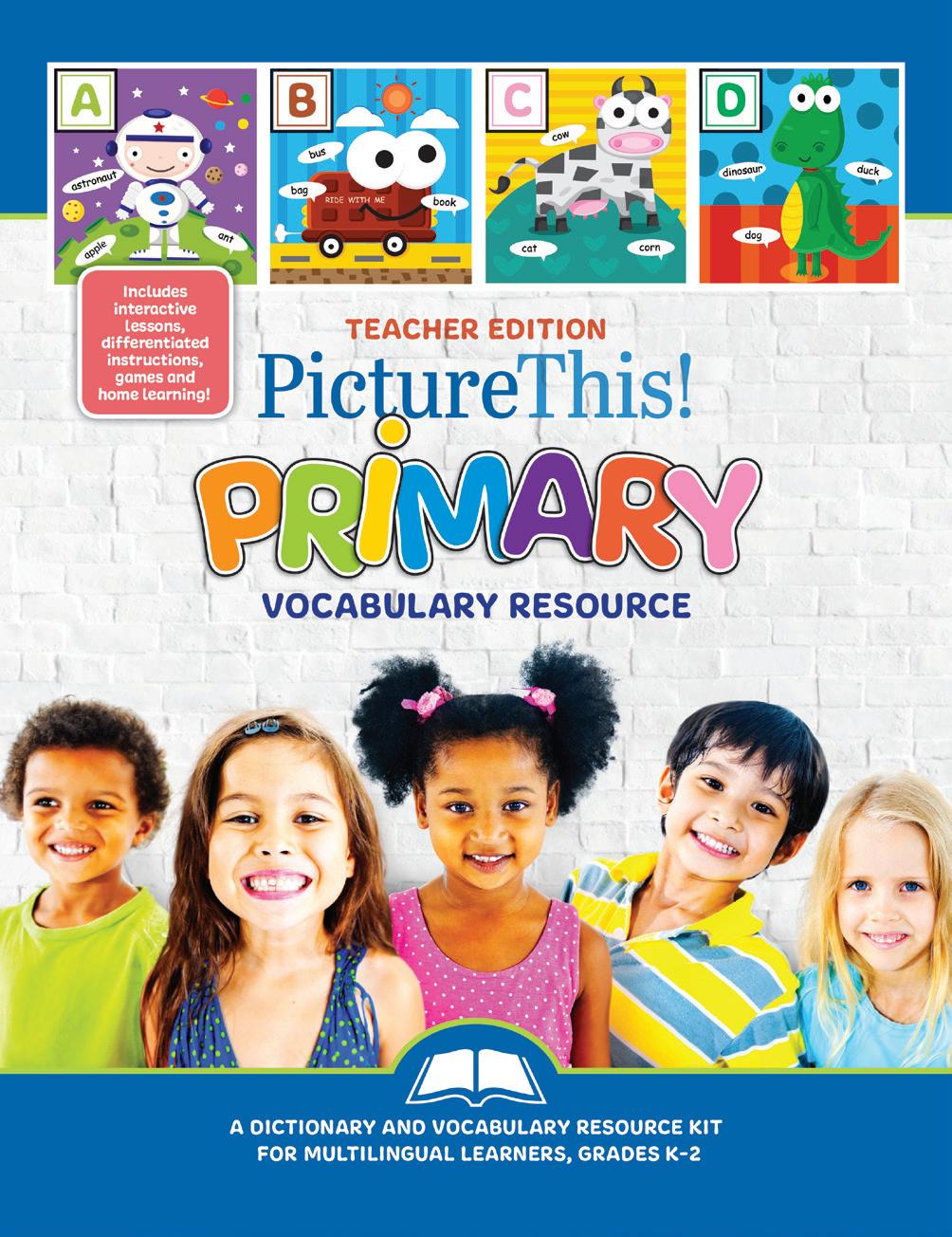
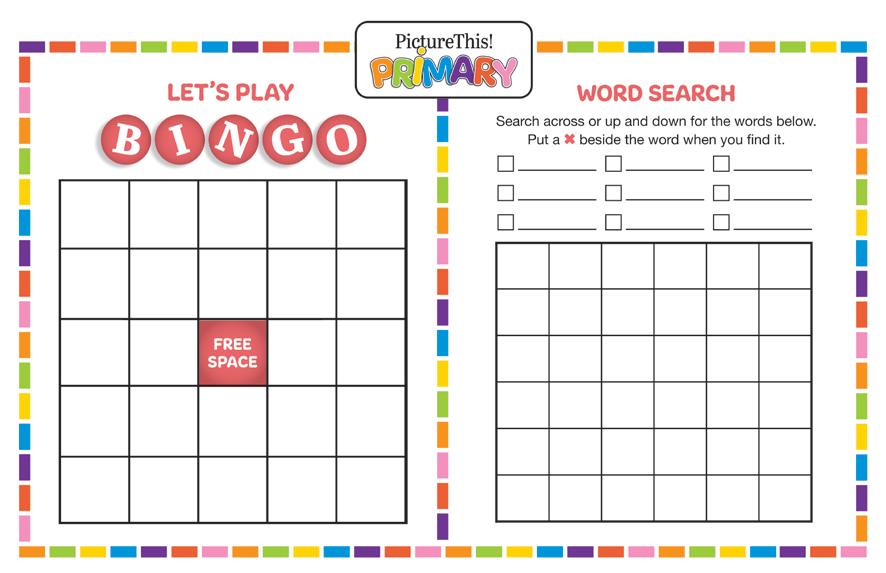
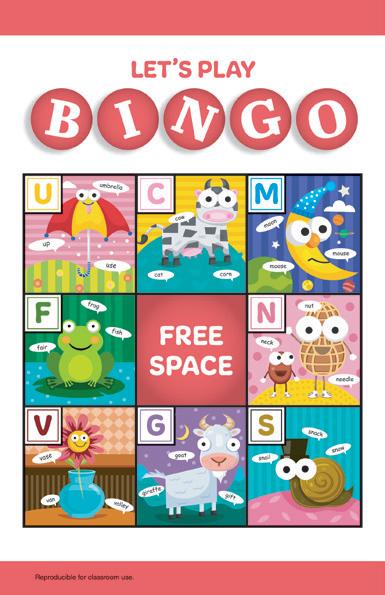
PictureThis! Primary Vocabulary Resource Kit helps bridge students’ English learning with early literacy strategies. The included picture dictionary will increase their access and knowledge of the English language. Vocabulary exposure and interactive language practice through activities and games will help students acquire and improve their listening, speaking, reading and writing skills in English!
The PICTURE THIS! PRIMARY VOCABULARY KIT includes Word-to-Word Dictionaries, support activities, thematic lessons and games to increase literacy proficiency while having fun!
Student Tools:
• PictureThis! Activity Mats for writing practice and games (includes dry-erase markers for paired, small group and center activities)
• Starter set of preprinted games and student activity pages in full color
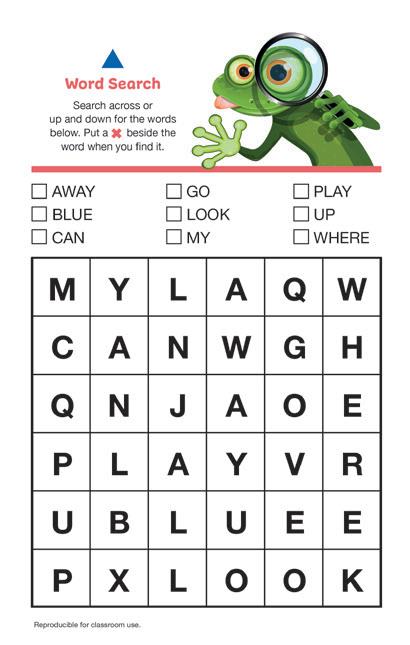
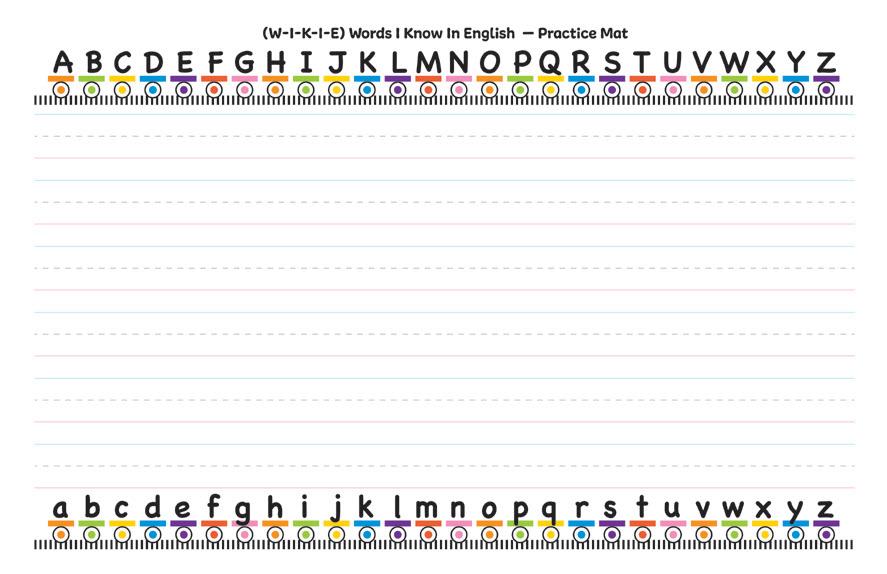

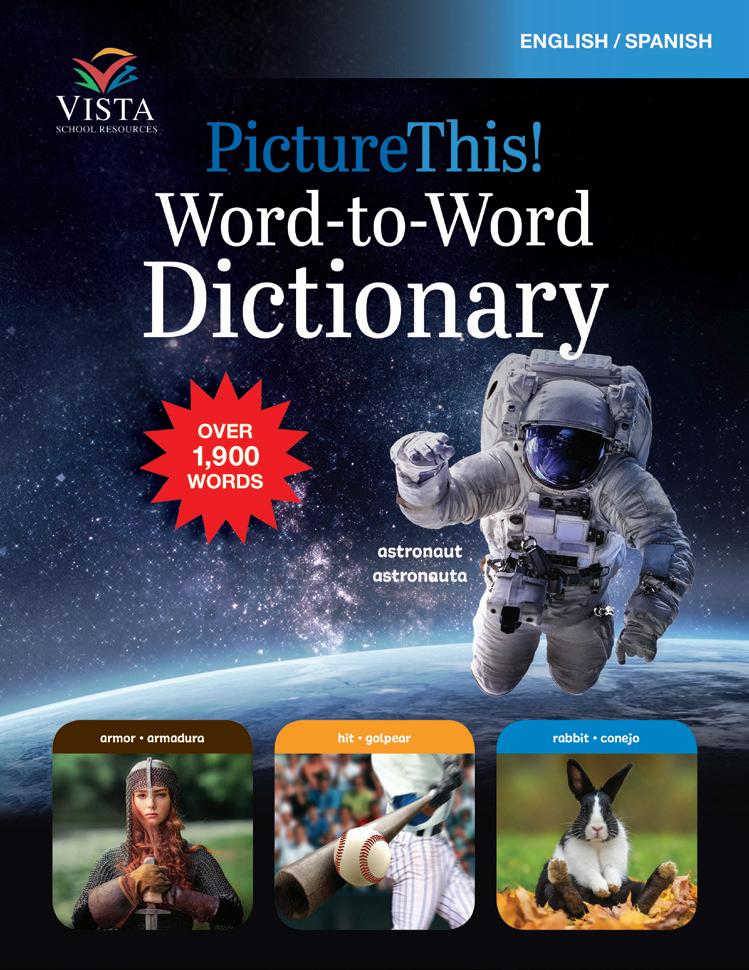

The PictureThis! Primary Vocabulary Resource Kit introduces English-language learners to early literacy strategies. Through activities, games, vocabulary exposure and practice, students will improve their listening, speaking, reading and writing skills.
The Kit combined with the PictureThis! Word-to-Word Dictionary with over 1,900 full-colors pictures, makes learning the English language easy and fun!